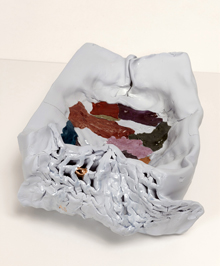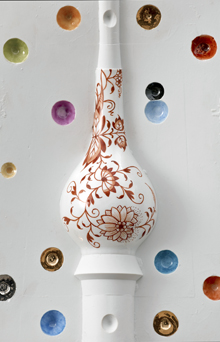
SMOOSHED 'Pale Blue Pillow.' |
I guess I should be just fine with “Meissen Recast,” Arlene Shechet’s exhibition at the RISD Museum (224 Benefit St, Providence, through July 6). A good deal of the art is handsome, after all. But it’s the premise behind it and its affiliation with a tired flavor of late postmodernism that bug me.
But let’s begin with the art. The New York sculptor fills two museum galleries with absurdist porcelain mashups. A rectangular box sprouts more than a dozen handles of varying designs down one side. Rudely stuck in the top is a little statue of a child with a gold ear and a flower stuck in its mouth. Elsewhere is Can Can, a large plain dish with a statue of a lady’s ruffled skirt stuck on like a big barnacle.
Monuments are a group of cups, stacked sort of like columns and sprouting odd leafy things. Pale Blue Pillow resembles a smooshed casserole dish used as a palette for painting brown, gold, black, turquoise, and green.
The surface of one large vase looks like it’s been hastily reassembled from broken pottery shards. Holes puncture the sides like wounds. A number of squashed cups, sculptural flowers, and other items are seemingly tossed in the top like garbage. A ceramic bird perches atop the pile. It’s all splashed with black-gray glaze that makes it look singed.
The most beautiful piece is a creamy white porcelain box, seemingly broken and folded in half, to reveal honeycombed guts glistening silver, gray, and turquoise. The outside is decorated with a pattern of gray and blue willow leaves. The overall effect resembles a traditional Chinese ink drawing of a mountain.

IN THE TRADITION 'Asian Vase.' |
The backstory premise of the exhibit is that Shechet was an artist-in-residence at “the world-renowned Meissen [porcelain] Manufactory” near Dresden, Germany, in 2012 and ’13. And that her porcelain sculptures here are based on 47 plaster molds the factory has been using for three centuries.
The RISD Museum points us toward the artist’s process: “Her porcelain sculptures highlight the seams, indentations, inventory numbers, and other evidence of the working process than an 18th-century craftsman would have sought to erase.” It is with this understanding that we’re supposed to appreciate Asian Vase, which seems like a cast of a factory mold, showing something of how the Germans traditionally have made these things.
But Shechet’s style here isn’t so much about tradition, but about crushing and smashing, about broken shards and destruction. A feeling of graffiting or looting pervades, with the occasional curiously direct evocation of violence. Laying Lion is a little statute of a woman, with a missing arm, seemingly crushed under a block. Her face is hidden behind a lion face/mask. A pale blue puddle oozes around her head like blood.
Are we to take this smashing of tradition literally? Could Shechet be offering a critique of the coquettish, pastoral decadence of traditional Meissen-style ceramics? It feels more like the luxury of being able to smash lovely, valuable things.
Shechet was praised last year by the prominent critic couple Roberta Smith and Jerry Saltz in The New York Times and New York magazine, respectively. And she made the cover of Art in America in January 2012 for her eccentric blobby ceramics that sort of resemble squashed and stretched bodies and organs. Her earlier sculptures have included collections of vessels, rope-like sculptures, and purposely crude plaster Buddhas.